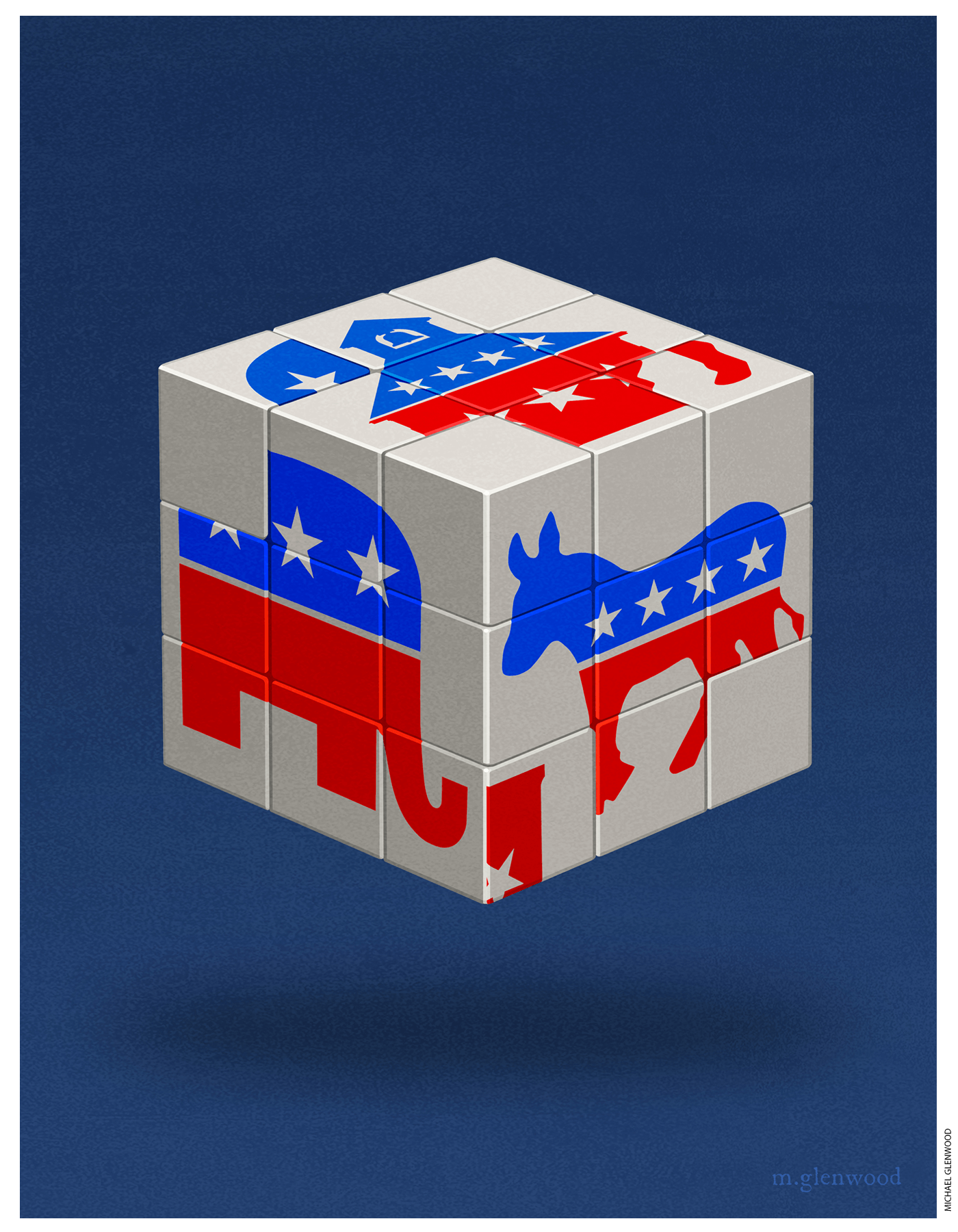
It can be difficult to keep track of all of the contemporary debates roiling the politics of education. On any given day, news headlines might be highlighting our sharp disagreements over how best to teach about race and racism in America’s past and present, the rights of gay and transgender students (and their parents), the passage of new school choice legislation, the ongoing legacy of pandemic-era learning loss, rising rates of chronic absenteeism, or the value of cell phones and artificial intelligence in schools—to name a few.
It would be both reductive and inaccurate to characterize these debates as mere distractions. Each of them reflect real differences in how Americans view the roles and responsibilities of schools in our large, diverse, and divided society. Yet a close look at the results of public opinion surveys reveals an important and often overlooked truth: the American public is less concerned about these hot-button issues than about the nuts and bolts of teaching and learning.
It has been a banner year for high-quality, scientifically rigorous polling of the public’s attitudes toward education issues. Not all surveys are created equal, and some do a better job than others of assembling a representative sample of U.S. adults and eliciting their unvarnished views. In general, surveys that recruit participants by dialing random phone numbers or mailing random addresses—a time-consuming, complex, and increasingly expensive process—have a stronger track record than their proliferating counterparts that recruit participants via the Internet. Even after applying statistical adjustments to make their samples look more like the population as a whole, polls that recruit participants online are more likely to capture unusual subsets of the American public, whose views do not necessarily generalize to the entire country.
To get a clearer sense of what Americans want from their schools, I sought out surveys conducted over the last 12 months that employed phone-based or address-based sampling and that also inquired about education issues. I collected relevant surveys from some of the most well-established and respected names in public opinion research, such as Pew Research Center and Gallup. I also drew on the insights of high-quality surveys that focus more narrowly on education, such as the PDK Poll of the Public’s Attitudes Toward the Public Schools, the EdChoice Schooling in America Survey, and the education module of the Understanding America Study.
Collectively, the results of these surveys portray an American public disappointed in the current state of K–12 education and pessimistic about its future. But Americans have always dreamed big when it comes to the promise of education, and that remains true today. The way back to those grand aspirations, according to the polls, runs through a renewed focus on issues such as student safety, attracting and retaining good teachers, high-quality curriculum, and school spending rather than the many ancillary debates that have come to dominate media coverage.
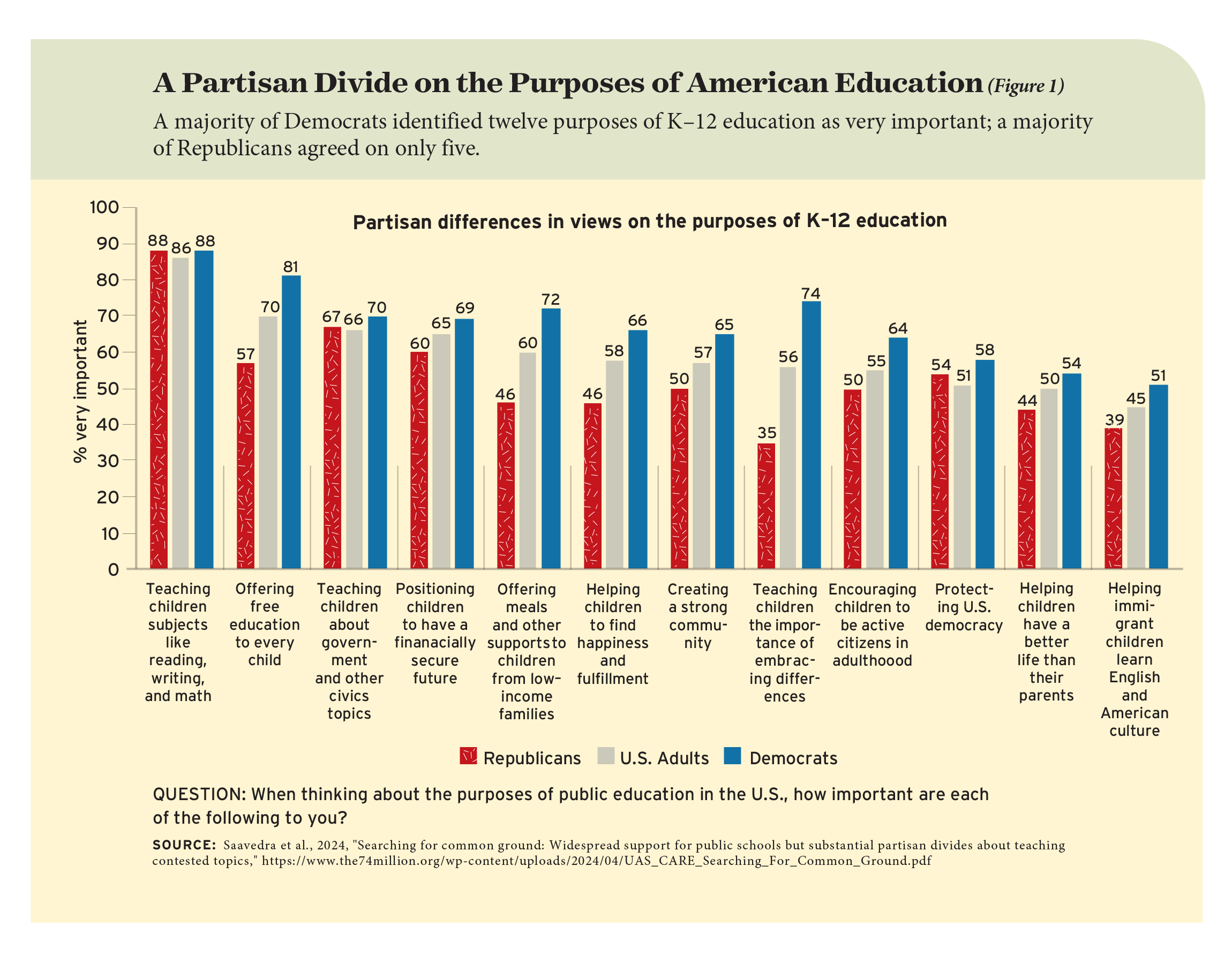
The Purposes of Education
Let’s get right to the heart of the matter: What do Americans think the aims and objectives of K–12 education ought to be? Broadly speaking, Americans would like schools to help mold students into astute thinkers, productive workers, engaged citizens, and decent human beings. Once we dig into the details, however, we begin to see significant disagreements that break down along party lines. Most Republicans want schools to be selective about their mission. Most Democrats, in contrast, favor a more inclusive, “all-of-the-above” approach.
The EdChoice monthly public opinion tracker, the online counterpart to their annual Schooling in America Survey, featured an experiment that divided the sample into two groups. Half of the respondents were asked to evaluate a list of potential purposes of education in grades K–8. The other half were asked to evaluate the same list for high schools. Large majorities said it is very or extremely important for students to learn the core academic subjects like reading, math, and science (86% in grades K–8 and 84% in high school); how to interact with others (86% and 84%); how to become independent thinkers (85% and 88%); how to be good citizens (83% and 84%); skills for future employment (82% and 90%); and values, moral character, or religious values (74% and 75%). Slightly smaller majorities said it is very or extremely important for students to learn how to fix social problems (58% and 68%).
The Understanding America Study offered respondents more educational objectives to consider. The question wording differed slightly (“When thinking about the purposes of public education in the U.S., how important are each of the following to you?”) as did the response options (which included “very important” but not “extremely important”). The most popular purposes nonetheless aligned closely with those identified by EdChoice: teaching children subjects like reading, writing, and math (86% very important); offering free education to every child (70%); teaching children about government and other civics topics (66%); positioning children to have a financially secure future (65%); and offering meals and other supports to children from low-income families (60%). Somewhat smaller majorities suggested that helping children to find happiness and fulfillment (58%), creating a strong community (57%), teaching children the importance of embracing differences (56%), encouraging children to be active citizens in adulthood (55%), and protecting U.S. democracy (51%) are very important.
Almost half of respondents indicated that it is very important for public schools to help children have a better life than their parents (50%) and to help immigrant children learn English and American culture (45%).
While nearly all of these purposes would seem to have broad support, disaggregating the Understanding America Study results by political party affiliation reveals a key fault line (see Figure 1). A majority of Democrats said all purposes listed above ought to be viewed as very important. Among Republicans, this was true of only five items: teaching children the core academic subjects, teaching about government and civics, preparing students for financial success, protecting U.S. democracy, and offering a free education to all.
In short, a majority of Americans support a wide variety of educational goals, but the aggregate results conceal noteworthy partisan disagreements. Most Democrats conceive of the purview of K–12 education expansively, including not only traditional academic and civic goals but also attempts to improve social welfare broadly. Most Republicans would prefer schools embrace a narrower range of objectives.
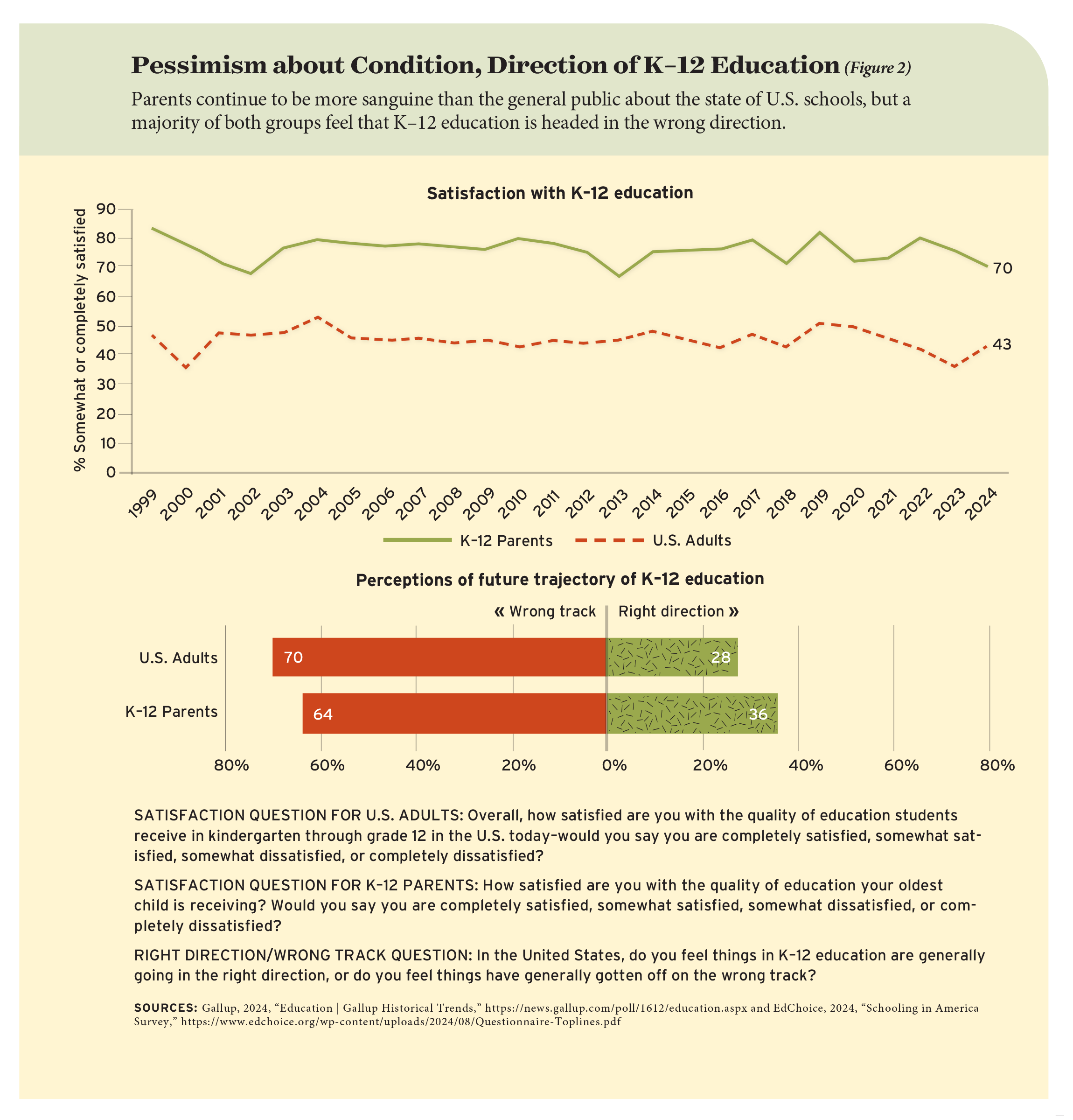
Satisfaction with the Education System
Americans may have grand educational ambitions, but they are pessimistic about the state of K–12 education. Less than half say they are satisfied with the quality of education students receive, and a majority thinks the school system is headed in the wrong direction. Parents of school-age children—as is typically the case—tend to be more upbeat about the current state of affairs, but they are similarly gloomy about the future.
As of August 2024, only 43% of American adults indicated they are somewhat or completely satisfied with the quality of education students receive in kindergarten through grade 12 in the United States today (see Figure 2). Gallup has asked this question annually since 1999. Satisfaction is down from its pre-pandemic high (51% in 2019) and up from its post-pandemic low (36% in 2023), but this year’s results hew pretty close to the average across more than 20 years of data. Among parents with a K–12 school-age child, satisfaction is notably higher: 70% say they are somewhat or completely satisfied with the quality of education their oldest child is receiving. Parental satisfaction varies modestly by school sector, but majorities in each category say they are somewhat or very satisfied with their child’s school. The EdChoice Schooling in America Survey disaggregated the results of a similar question for respondents with a child in a public district school (69% somewhat or very satisfied), charter school (76%), private school (78%), or homeschooled (79%).
The EdChoice survey also asked respondents about the trajectory of K–12 education in the United States. The responses to this question were dire for both parents and the broader public. Fully 70% of the public thought K–12 education is on the wrong track. Among parents of school-age children, this value only inched downward to 64%. Pew Research Center asked a similar right/wrong direction question, but they also included a “not sure” response option. A majority of Americans still indicated they thought K–12 education was headed in the wrong direction (51%), but a nontrivial proportion hedged by saying they were not sure (32%). Only 16% of Americans were willing to say things were going in the right direction.
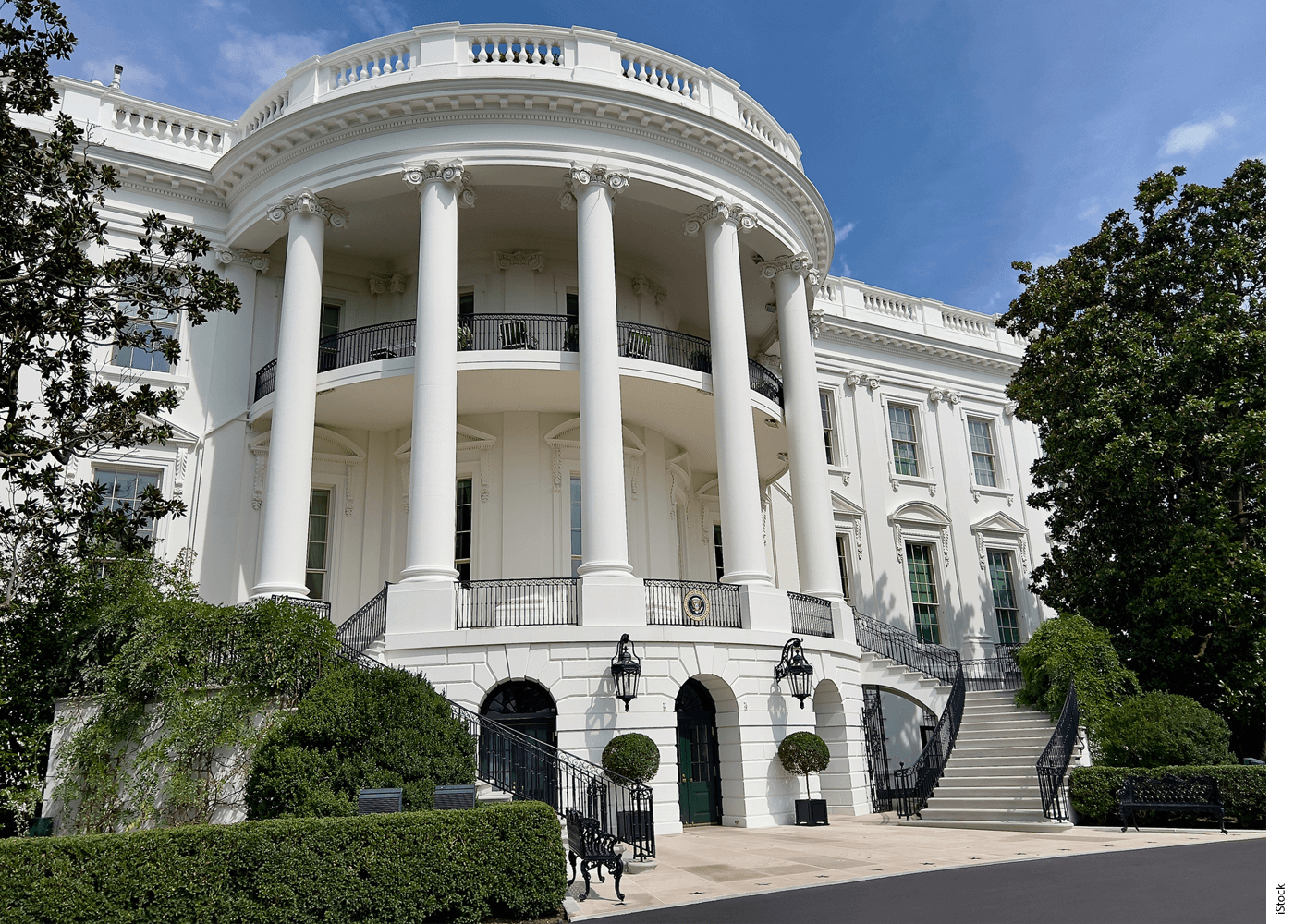
In the Pew survey, both ends of the spectrum featured moderate partisan gaps. Compared to their Republican counterparts, Democrats were 13 percentage points more likely to say “right direction” and 15 percentage points less likely to say “wrong direction.” Perhaps more illuminating were Democrats’ and Republicans’ rival explanations of why K–12 education is struggling. A majority of Republicans who answered “wrong direction” said schools are not spending enough time on core academic subjects (79%) and teachers are bringing their personal political and social views into the classroom (76%). Meanwhile, a majority of Democrats said schools do not have the funding and resources they need (78%).
In other words, Americans are in agreement that the K–12 education system is off course. Even parents of school-age children, who are far more sanguine about the current state of affairs than their counterparts without young kids, are dubious about the direction the system is headed. That is where the consensus ends, however. Republicans are even more pessimistic about the future than Democrats, and partisans of both stripes identify different problems in the field and envision different remedies.
Importance of Education as an Issue
Given the K–12 education system’s relatively lackluster performance in the eyes of the American public, you might imagine that education is among the most important issues capturing the nation’s attention leading up to the presidential election. If so, you would be mistaken.
The way pollsters ask about this issue matters. The PDK Poll asked the question, “Thinking ahead to the election in November, how important is the issue of public education in your vote for president?” Majorities of American adults (54%) and public-school parents (70%) said public education is very or extremely important. However, just because education is perceived as important does not mean it rises to the top of a crowded agenda.
The EdChoice Schooling in America Survey framed the question differently. They provided a lengthy list of political issues and asked respondents to rank the three issues most important to them. Only 15% of the public placed K–12 education in their top three. This percentage rose to 27% among parents of school-age children. However, K–12 education still trailed behind quite a few other issues, including jobs and the economy (public: 60%, parents: 63%), healthcare (public: 41%, parents: 43%), gun violence (public: 34%, parents: 31%), and immigration (public: 32%, parents: 28%).
Gallup, which has asked its “most important problem” question on a nearly monthly basis since 2001, does not provide a list of issues from which respondents can choose. Instead, the question allows respondents to provide any answer, and the survey research firm categorizes their responses. In their most recent survey, only 2% mentioned education in their answer—a fraction of the percentage that mentioned the high cost of living or inflation (15%), the economy in general (18%), or immigration (19%).
Within the broader category of education, some issues are perceived as more important than others. The PDK Poll asked respondents to opine on what the next presidential administration, regardless of who wins the election, ought to prioritize (see Figure 3). The nuts-and-bolts of teaching and learning topped the list: 84% wanted the next administration to focus more on preparing students to enter the workforce, and 81% wanted the next administration to focus more on efforts to attract and retain good teachers. Reforms that captured quite a bit of media attention over the last decade, such as the availability of public pre-K programs (56%) and the expansion of charter schools (35%), garnered less enthusiasm.
The EdChoice Schooling in America Survey also captured Americans’ desire to refocus on the fundamentals. The most popular education issues were school safety (66% of the public ranked this in their top three issues), curriculum (41%), and school funding (41%). Other issues, including some that have landed at the center of recent political debates, were perceived as less important by the American public: parental choice in K–12 education (20%), technology in K–12 education (15%), and democratic values and citizenship (15%).
In sum, there is little evidence that K–12 education is among the most pressing issues on the public agenda as the 2024 presidential election approaches. However, when pressed on the education issues that matter most to them, Americans express less interest in the heated debates about democratic values, technology in the classroom, and school choice. Instead, they want elected officials to focus on hiring and keeping good teachers, the content of the curriculum, school spending, and students’ safety.
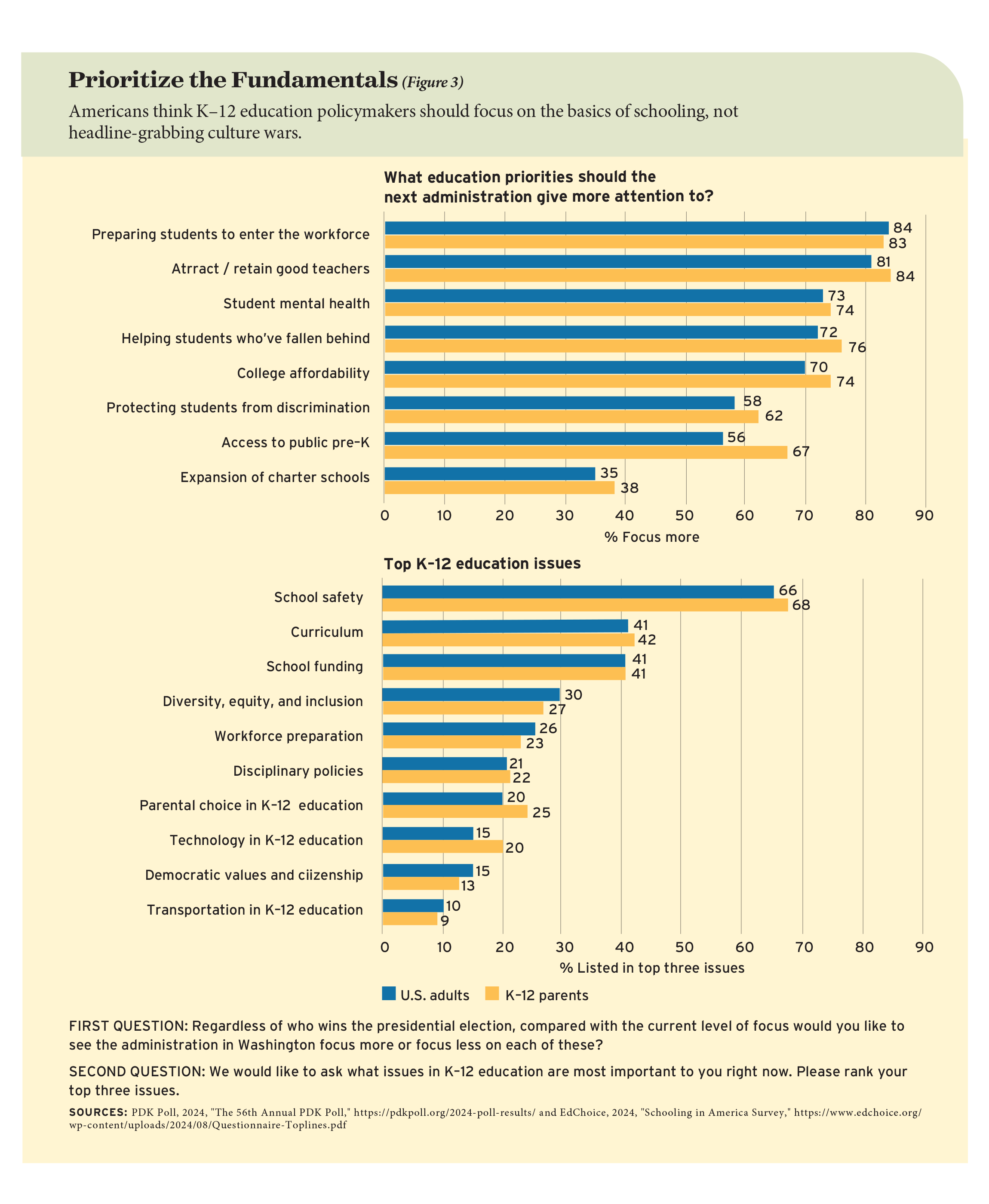
Pandemic Learning Loss and Rising Absenteeism
Although students’ academic performance has begun to recover from the sharp decline sparked by the Covid-19 pandemic, it remains well below 2019 levels. Moreover, the stark inequality that characterized student achievement prior to the pandemic has only intensified in its wake. Yet, despite the ongoing toll of pandemic learning loss, none of the surveys in this annual round-up asked specific questions about the subject. Earlier polling suggested that relatively few Americans—including parents of school-age children—were particularly worried about learning loss or whether kids would catch up to pre-pandemic standards. The PDK Poll asked about the topic obliquely when it inquired if participants would like to see the next presidential administration focus more or less on providing extra help to students who have fallen behind academically. A robust 72% of U.S. adults and 76% of public-school parents indicated they wanted more attention on this issue. However, it is difficult to know whether respondents were thinking about efforts to recover from the pandemic or if they had more typical levels of student-to-student variation in mind.
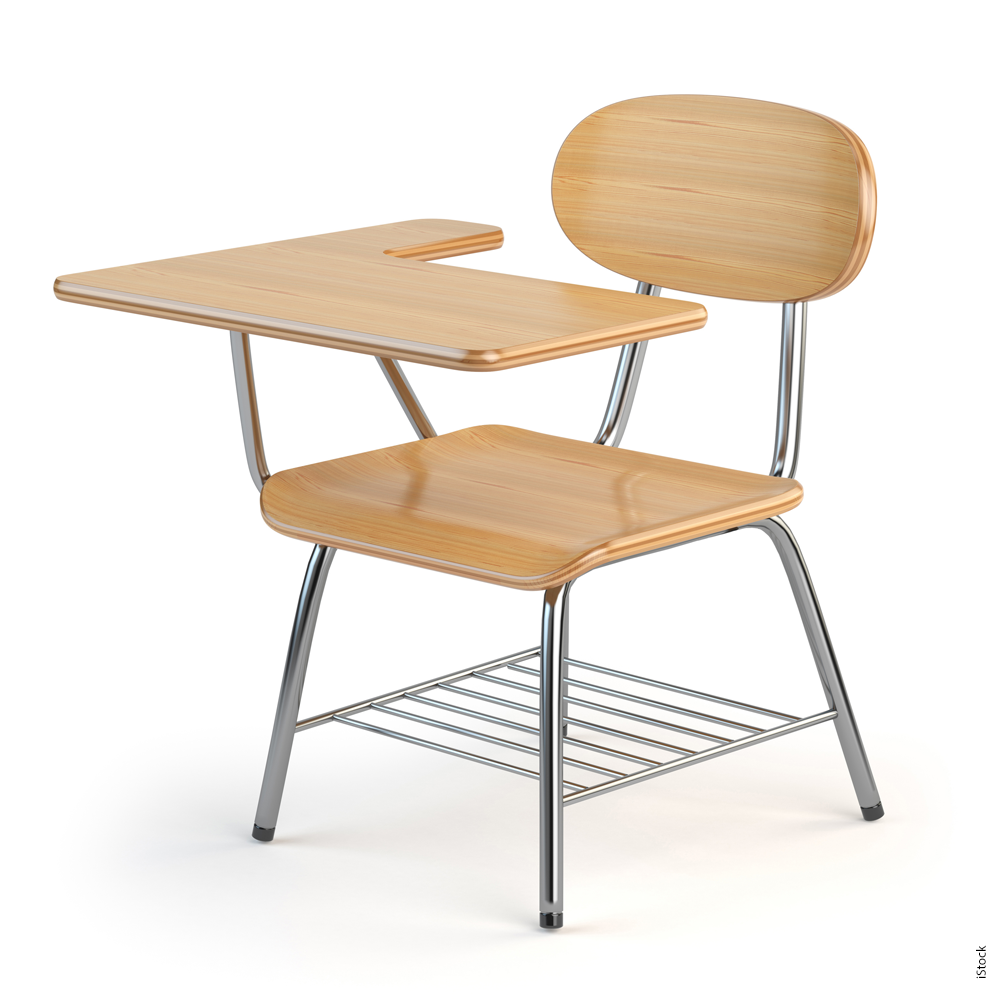
Other polls focused on another troubling legacy of the pandemic: rising student absenteeism. Much like pandemic-era learning loss, few parents appear to be aware of or particularly concerned about student absences. The Understanding America Study revealed that only about 5% of parents and caretakers of school-age children reported that their child had missed 10 or more days of school (which, at the time, would put them on track to be absent more than 10% of the school year, the typical benchmark for chronic absenteeism). However, state data on chronic absenteeism suggests that the actual rate is much higher in many states. Only about 8% of parents and caretakers indicated they were concerned about their child’s absences.
Technology, Cell Phones, and Artificial Intelligence
The use of technology in schools—especially cell phones and artificial intelligence (AI)—has sparked heated debate. However, compared to other education issues, technology in K–12 classrooms ranks relatively low on the public’s list of priorities. As shown in Figure 3, only 15% of the public and 20% of parents think it is a top-three issue in terms of importance. Moreover, 83% of parents are somewhat or very satisfied with their child’s use of technology in school, and 80% are somewhat or very satisfied with how their child’s school uses technology. Consistent with the recent debates over cell phones and AI, parents are more supportive of the classroom use of laptops (86% somewhat or strongly support), tablets (84%), 3D printers (77%), and online learning platforms such as Google Classroom, Canvas, and Blackboard (84%) than AI programs (52%) or cell phones (40%). EdChoice’s monthly public opinion tracker asked a slightly different question about cell phones, revealing a bit more nuance. While 66% of parents think their child should be allowed to have a cell phone in school, only 35% think their child should be allowed to have one in the classroom.
The PDK Poll collected data on the public’s attitudes toward specific uses of AI in K–12 classrooms. Majorities of the U.S. public and public-school parents support using AI to prepare lesson plans for teachers to review and use (62% of the public and 66% of parents), to tutor students via interactive computer applications (65% public, 66% parents), and to have students practice taking standardized tests (64% public, 63% parents). However, allowing students to use AI to help with their homework is less popular (43% public, 50% parents). In the EdChoice survey, the notion that schools have a responsibility to teach students how to use AI responsibly garnered the support of 60% of U.S. adults and 65% of parents.
Pew Research Center conducted multiple surveys inquiring about public K–12 teachers’ and students’ attitudes toward cell phones and AI. Teachers’ concerns about cell phone usage are concentrated in the upper grades: 72% of high school teachers said students being distracted by their cell phones is a major problem, compared to 33% of middle school teachers and only 6% of elementary school teachers. Students, meanwhile, are more upbeat. Fully 70% of U.S. teens aged 13 to 17 said, when it comes to people their age using a smartphone, there are generally more benefits than harm. Teachers’ attitudes toward AI are mixed. About a quarter of public teachers think AI tools in K–12 education generate more harm than benefits. Large proportions suggested there is about an equal mix of benefits and harm (32%) or were not sure (35%). Only 6% were willing to say they believe AI brings more benefits than harm.
To recap, despite the high levels of media attention prompted by questions of cell phone usage and AI, only a small proportion of Americans think technology in K–12 classrooms ought to be a top priority. However, despite its relatively low salience, some patterns are emerging. Polls reveal a fair amount of skepticism about the value of cell phones in the classroom and middling support—with lots of uncertainty—regarding AI.
Race and Sexuality
Arguments over how educators ought to teach about race and sexuality have erupted in classrooms, at school board meetings, and across news headlines. These issues generate some of the sharpest disagreements in the broader domain of K–12 education policy. Specifically, the gaps in public opinion between Democrats and Republicans on many questions involving race and sexuality dwarf the gaps on most other education issues. Yet even amidst all this turmoil and tension, a few points of convergence persist.
The Understanding America Study included a large battery of items inquiring about Americans’ attitudes toward classroom instruction on a variety of potentially controversial issues. The results reveal stark partisan disagreements, especially on issues related to systemic racism and gender identity. For example, Democrats are a whopping 47 percentage points more likely to support a high school assignment “asking students to reflect on how discriminatory U.S. policies, like unfair housing practices and unequal access to healthcare, have negatively impacted Black and Hispanic Americans.” Similarly, Republicans are also 47 percentage points less likely to support high school discussions “about how some people’s gender identities may not match their biological sex.”
Not every race- and sexuality-related issue divides the public along party lines. A majority of Americans (including most Republicans) support high school content on equal treatment regardless of skin color, how colonists harmed Native Americans, interracial marriage rights, how some white Americans opposed the civil rights movement, acting out civil rights demonstrations, slavery as the main cause of the Civil War, racial wealth gaps, and acknowledgments of the Native American tribes who once lived where the classroom now sits. Only one sexuality-related issue at the high-school level garnered bipartisan support: a reading assignment with a heterosexual love story. The age of the students in these scenarios also mattered immensely, with less overall support and less partisan disagreement about the appropriateness of these topics for students in elementary school.
Teachers also appear to be split on these matters. According to a Pew Research Center survey, a majority of public K–12 teachers (64%) said students should learn that the legacy of slavery still affects Black Americans today. However, nearly a quarter of teachers (23%) said students ought to learn that the effects of slavery have long since subsided, and a small subset (8%) think this topic in general is inappropriate for school. Teachers’ attitudes toward instruction about gender identity is even more divided. Only 33% of public K–12 teachers said students should learn that someone’s gender can be different from the sex they were assigned at birth, 14% said students should learn that gender is determined by the sex that someone is assigned at birth, and fully 50% said students should not be learning about this topic at all at school.
The same survey also inquired about whether U.S. adults think parents should be able to opt their children out of instruction about race- and sexuality-related issues when the material conflicts with parents’ personal beliefs. The pattern of responses was notably different for instruction about race than for instruction about sexuality. A majority of Americans (52%) think parents should not be able to withdraw their children from learning about racism or racial inequality; only 34% supported the option to opt out. The reverse was true with respect to learning about sexual orientation or gender identity. A majority of Americans (54%) think parents should be able to withdraw their children from such classroom discussions; only 31% opposed the option to opt out.
School Choice
The last three years have seen an enormous expansion in the kinds of policies that allow parents to choose from a wider variety of educational options—including traditional public schools, charter schools, and private schools—with public money supporting some or all of the cost. Approximately 40% of parents of elementary and secondary students report having the option of sending their children to a public school other than the one for which their home is zoned. Nearly four million students now attend a charter school, and more than one million students are now participating in a private school choice program.
Polling reveals a public that is closely divided—with perhaps a slight edge in favor of expanded choice—on many of the specific policies being discussed across the country. Yet despite the dramatic changes afoot in the school choice landscape, most Americans tend to place relatively little stock in the importance of these issues. As previously mentioned, the EdChoice Schooling in America Survey revealed that only 20% of the U.S. public (25% of parents of school-age kids) rank “parental choice in K–12 education” in their top three most important education issues, significantly trailing other concerns such as curriculum, spending, and school safety. Similarly, when asked about the potential priorities of the next presidential administration, only 35% of PDK Poll respondents indicated they want to see a greater focus on the expansion of charter schools, compared to much greater interest in areas such as teacher recruitment and student mental health (see Figure 3).

The EdChoice survey breaks down the public’s support for a variety of different school choice policies. About 56% of the public and 66% of parents somewhat or strongly support the general idea of school choice. Similar percentages support charter schools (55% public, 64% parents), school vouchers (51% public, 59% parents), and education savings accounts (50% public, 58% parents). The survey designers at EdChoice randomly assigned some respondents to receive alternate versions of these questions that included brief descriptions of the policies. In each case, support for these forms of school choice increased. This could suggest that Americans might become more supportive of these initiatives the more they know about them. However, if Americans become more familiar with and knowledgeable about these policies, they would also surely encounter a wider range of arguments for and against them. It is therefore difficult to predict which direction a more informed public might shift. Sizeable majorities also expressed support for scholarships funded by tax credits (69% of the public and 79% of parents), inter-district open enrollment (74% public, 81% parents), and homeschooling (65% public, 69% parents)—although the survey items inquiring about these issues only provided a single version that included specific descriptions of the policies.
The Understanding America Study fielded a set of questions tackling this topic from a different angle: whether Americans agree or disagree with some of the underlying justifications for and against expanded school choice. Their results reveal a nearly 50-50 split on a series of statements: students in private schools generally learn more than students in public schools (52% agree); competition for students makes public schools more careful in how they use resources (51%); if students leave public schools for other types of schools, the quality of public schools will get worse (50%), charter and private schools take higher-performing students, leaving public schools with fewer of them (48%), competition for students ultimately makes public schools better (41%), and sending students to charter or private schools increases segregation among students (40%). The one area in which the Understanding America Study found nearly unanimous agreement was a scenario featuring federal funding for schools. Fully 73% of Americans, including 85% of Democrats and 67% of Republicans, said the federal government should give money to public schools to improve their quality rather than giving money to low-income families so they can pay for private school. The specific contours of public opinion regarding school choice may be difficult to capture, but there appears to be a limiting principle when it comes to federal intervention.
EdNext in your inbox
Sign up for the EdNext Weekly newsletter, and stay up to date with the Daily Digest, delivered straight to your inbox.
School Spending
Approximately 41% of Americans think school funding is among the top three most important education issues, according to the EdChoice Schooling in America Survey. However, despite its high salience, public opinion on the matter is difficult to characterize precisely. Based on the results of the PDK Poll, 61% of U.S. adults and 71% of public-school parents said they are more likely to vote for a candidate for elected office if they intend to increase funding for public schools. This closely matches the 63% of U.S. adults in the EdChoice Schooling in America Survey who said public-school spending in their state is currently too low. However, when provided with information about current per-pupil expenditures in their state, that 63% declines to 44%. The Education Next poll, which was last fielded in 2022, captured a similar result: 59% of U.S. adults supported increased spending in the abstract, but that value shrunk to 48% among respondents who were provided with current per-pupil spending levels in their community.
While it is difficult to pin down what the majority of Americans think about education spending in general, the majority’s preferences regarding teachers’ salaries are much clearer. Data from the Pew Research Center indicates that 74% of U.S. adults think public K–12 teachers should be paid somewhat or a lot more than they are now. While the Pew survey did not conduct an experiment featuring information about local teachers’ salaries, the 2022 Education Next poll did: 72% of U.S. adults supported increased teachers’ salaries in the abstract, dropping to a still-substantial 60% among respondents who were provided with current teacher compensation data from their state. When informed of current salary levels, Americans think teachers should be paid more.
Time to Refocus
Education is inherently political. It will never be a conflict-free zone, nor should it be in a diverse society committed to collective goals. Americans disagree about a large and growing number of education issues, and the basis of many of those disagreements is increasingly political party affiliation, a prominent part of our personal and social identities. Partisan polarization is now a central feature of contemporary American politics, and, regardless of the outcome of the upcoming election, that is unlikely to change.
It is neither possible nor desirable to wish away the disputes that complicate the path toward stronger schools and school systems. As the polls suggest, the American public has little interest in simply disregarding its differences. However, Americans do not imbue every debate with the same degree of significance. Some matter more than others, and there may be advantages to narrowing the scope of conflict to those aspects of education policy that bear directly on top-tier priorities, like ensuring student safety and improving teaching and learning in core academic subjects. To be sure, there is no shortage of conflict on how best to accomplish those goals. When the range of disagreement is limited and manageable, however, the opportunities for strategic collaboration may be easier to identify and pursue.
David M. Houston is an assistant professor of education in the College of Education and Human Development at George Mason University.
This article appeared in the Winter 2025 issue of Education Next. Suggested citation format:
Houston, D.M. (2025). The Year in Public Opinion on U.S. K–12 Education Policy. A review of surveys finds Americans want schools to refocus on teaching and learning. Education Next, 25(1), 22-31.


